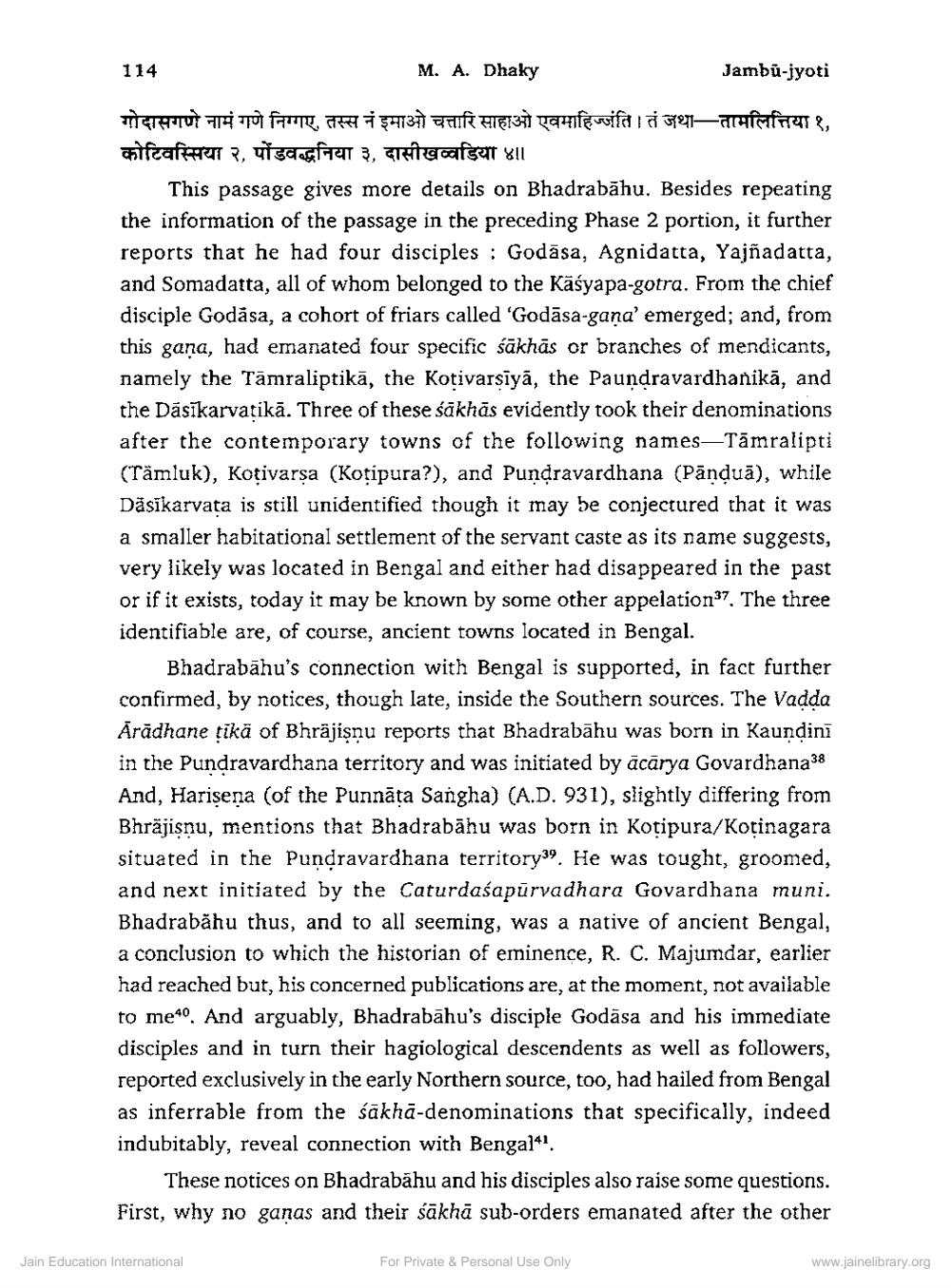Book Title: Arya Bhadrabahu Author(s): M A Dhaky Publisher: Z_Nirgranth_Aetihasik_Lekh_Samucchay_Part_1_002105.pdf and Nirgranth_Aetihasik_Lekh_Samucchay_Part_2 View full book textPage 7
________________ 114 M. A. Dhaky Jambu-jyoti गोदासगणे नामं गणे निग्गए, तस्स नं इमाओ चत्तारि साहाओ एवमाहिज्जंति। तं जथा—तामलित्तिया १, कोटिवस्सिया २, पोंडवद्धनिया ३, दासीखव्वड़िया ४॥ This passage gives more details on Bhadrabāhu. Besides repeating the information of the passage in the preceding Phase 2 portion, it further reports that he had four disciples : Godāsa, Agnidatta, Yajñadatta, and Somadatta, all of whom belonged to the Käsyapa-gotra. From the chief disciple Godása, a cohort of friars called 'Godāsa-gana' emerged; and, from this gana, had emanated four specific sākhās or branches of mendicants, namely the Tāmraliptikā, the Kotivarsīyā, the Paundravardhanikā, and the Dásīkarvatikā. Three of these sākhās evidently took their denominations after the contemporary towns of the following names—Tāmralipti (Tämluk), Kotivarsa (Kotipura?), and Pundravardhana (Pānduā), while Däsīkarvata is still unidentified though it may be conjectured that it was a smaller habitational settlement of the servant caste as its name suggests, very likely was located in Bengal and either had disappeared in the past or if it exists, today it may be known by some other appelation37. The three identifiable are, of course, ancient towns located in Bengal. Bhadrabāhu's connection with Bengal is supported, in fact further confirmed, by notices, though late, inside the Southern sources. The Vadda Ārādhane tikā of Bhräjisnu reports that Bhadrabāhu was born in Kaundini in the Pundravardhana territory and was initiated by ācārya Govardhana38 And, Harisena (of the Punnāta Sangha) (A.D. 931), slightly differing from Bhräjisnu, mentions that Bhadrabāhu was born in Koripura/Korinagara situated in the Pundravardhana territory39. He was tought, groomed, and next initiated by the Caturdaśapūrvadhara Govardhana muni. Bhadrabảhu thus, and to all seeming, was a native of ancient Bengal, a conclusion to which the historian of eminence, R. C. Majumdar, earlier had reached but, his concerned publications are, at the moment, not available to me. And arguably, Bhadrabāhu's disciple Godāsa and his immediate disciples and in turn their hagiological descendents as well as followers, reported exclusively in the early Northern source, too, had hailed from Bengal as inferrable from the sakha-denominations that specifically, indeed indubitably, reveal connection with Bengal“. These notices on Bhadrabahu and his disciples also raise some questions. First, why no ganas and their sākhā sub-orders emanated after the other Jain Education International For Private & Personal Use Only www.jainelibrary.orgPage Navigation
1 ... 5 6 7 8 9 10 11 12 13 14 15 16 17 18 19 20 21 22 23 24 25 26 27 28 29 30 31 32 33 34 35 36 37 38 39 40 41 42 43 44 45 46 47 48
